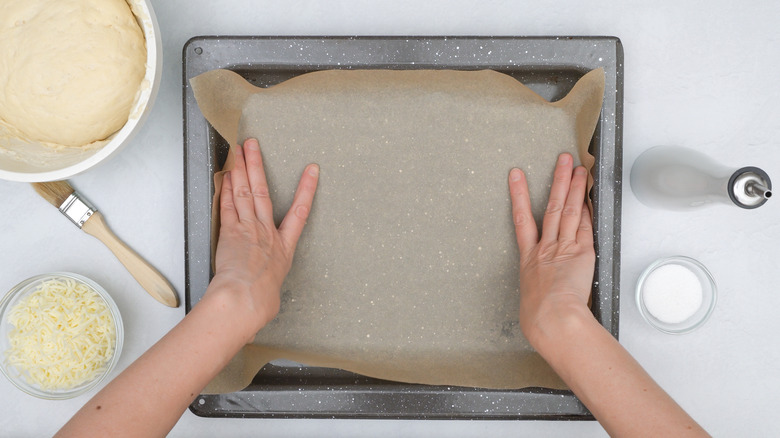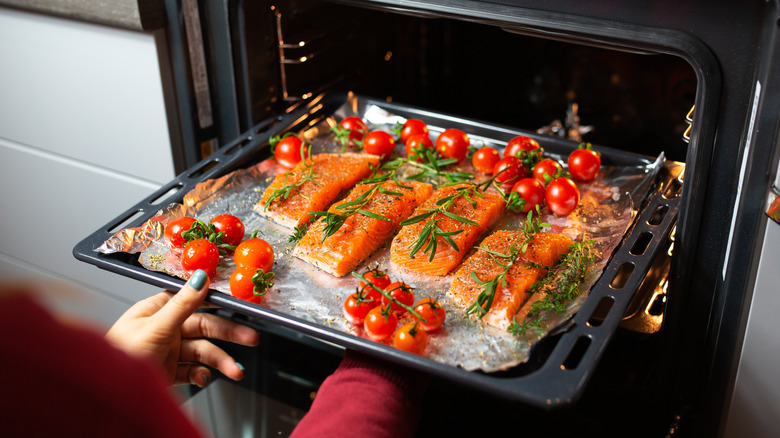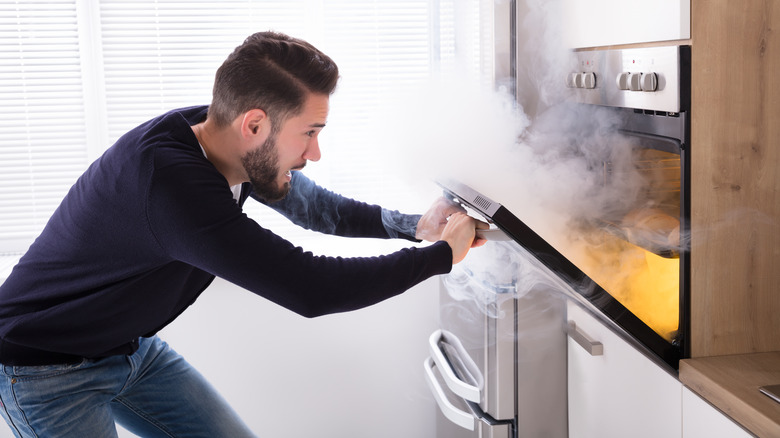You Should Think Twice About Putting Parchment Paper Under Your Broiler
When it comes to your household kitchen, there are many appliances you can use to whip up a delicious meal, such as a microwave, a conventional oven, or a stove. And if you don't have a grill, the broiler option on an oven is a popular method for cooking vegetables, fish fillets, and certain cuts of meat under very high heat settings. That's because a broiler acts like a grill, and according to Bon Appétit, it "functions as a direct, super-concentrated heating element" for cooking various foods. This function is also great for giving frozen foods or leftovers the crispiness they might lack after baking alone.
Broiler temperatures hover around 550°F, Healthline notes, so it's important to consider what you line your baking tray with. Most home cooks opt for aluminum foil, while others prefer parchment paper. But, according to Epicurious, this popular coated paper isn't immune to heat; its chemically-treated surface is simply heat-resistant. That distinction is critical. Here's what it means and how it relates to using your broiler.
How to safely use a broiler
According to Maytag, you'll need to first move your oven rack to the highest slot in the oven, just below the broiler. If you don't want an overly hot sear on your food, though, go ahead and position the oven rack a few slots down.
Like an oven, a broiler needs to be preheated. Once you've found the broiler button on your oven, turned it on, and let it preheat for a few minutes, you can place your dish inside. It's important to monitor what you're cooking since food can start to burn or even catch fire rather quickly in the extreme heat — so feel free to adjust the temperature settings or oven rack position (wear those oven mitts!) as needed.
If you find that your food has seared too quickly on the outside and is still undercooked on the inside, switching your device to its bake mode can ensure that heat is distributed throughout the oven once again, which will promote even cooking within your dish of choice without sacrificing that perfect crispy finish on the surface.
But even if you follow these instructions to the letter, your smoke alarm may go off if you don't use proper heat-proof materials.
Heat-resistant versus heat-proof materials
According to its definition by Merriam-Webster, when an item is heat-resistant, "it cannot be easily burned or melted." If an item is heat-proof, it "cannot be damaged by heat" (via the Oxford Learner's Dictionaries). Since parchment paper is heat-resistant only, there is an implication that it can be damaged by heat if temperatures are high enough. And since broiler temperatures are extremely hot, that's enough for parchment paper to melt or burn in your oven.
As noted by Epicurious, proximity plays a big role; if you place the parchment paper too close to the broiler at the top of your oven, it could ignite. An ignition may set fire to the foods you're cooking, or worse, to the entirety of your oven and home. Instead, it's better to opt for a broiler pan or a metal baking sheet lined with aluminum foil. Wire racks may also be safe to use up to a certain temperature, but be sure to check the manufacturer's directions first and avoid any racks with nonstick coating.
Next time you're baking or roasting, don't be afraid to whip out the parchment paper. But if you're getting your broil on, heat-resistant isn't quite going to cut it.


